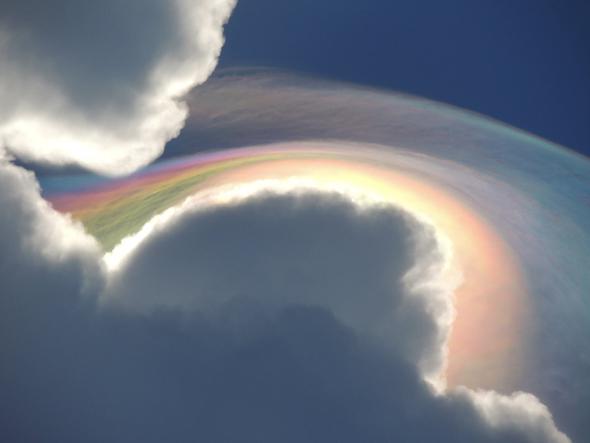Regular readers know how much I love a) clouds, and 2) optical phenomena in the sky, so I can say with complete honesty that this is by far the coolest pileus cloud with iridescence you’ll see all day.
OK, what?
Right. You’ll probably want some details.
This photo was taken by Beckie Bone Dunning on Oct. 29, 2015, when she was in Jamaica. There were storm clouds approaching, almost covering the Sun, when she snapped this shot. Being the huge dork that I am, I knew right away what was here.
First, the colors are from iridescence, a complicated physical phenomenon. I’ve written about this before:
Iridescence is a weird phenomenon. You need lots of tiny raindrops (or ice crystals) all the same size over a large portion of the cloud. In a rainbow, the lights goes into the droplets and gets bent (twice) to create colors. In iridescence, though, the light actually bends (diffracts) around the droplets. Different colors bend by different amounts, splitting the colors apart. The size of the raindrop needs to be roughly the same size as the wavelength of light, so when I say “tiny” I mean it: The drops must be less around a micron in size! A human hair, by the way, is about 100 microns in width, so these really are teensy drops.
But it’s more complicated than just that. The cloud also has to be what’s called optically thin; that is, mostly transparent so that on average a beam of light only hits one droplet and only gets bent once. If it hits multiple drops the colors get washed out. That’s why this happens more often near the edges of clouds, where they’re thinner. On top of that, the light waves interfere with each other, similar to how waves in a bathtub add together or subtract from each others’ wave heights as you wiggle around (and please, don’t deny you’ve ever done this playing in the tub; it’s fun, and educational!). These processes combine in complicated ways to produce these different colors.
Note that the colors in iridescence are different than the ones in rainbows because they’re generated in a different way; you can get teal, pink, and more from iridescence.
So that explains the colors. What about the weird, twisty shape?
Ah, that’s because this isn’t just a cloud, it’s a pileus cloud. These are thin, cap-shaped sheets of cloud that form above rapidly rising columns of air. For example, in a cumulonimbus cloud, the shaft you see is due to the warm air rising, which usually bubbles into that cauliflower-shape head at the top. If there is a humid layer of air above it, the rising air will push it up (like a fist pushing through a rubber sheet), where it expands and cools. If it cools below the dew point, droplets form, and you get a pileus cloud.
Pileus clouds are thin and have tiny water droplets in them. Perfect to make iridescence! You have to be at the right spot to see them, when the clouds are near the Sun … which is exactly where Dunning was. Voilà.
Amazing. I’d LOVE to see something like this. I’ve seen both pileus and iridescence before, but never at the same time. I’d expect it’s rare where I live; we tend to get cumulonimbus clouds forming to our east, as air rises over the Rockies and picks up moisture as it crosses the plains. That happens in the afternoon, when the Sun is to the west, so they happen in opposite spots in the sky. Ah well.
But that arrangement does supply us with a lot of rainbows, so I can be pretty happy with that, too.
More cool weather stuff:
- Double Rainbow … With Lightning!
- Dancing Lights Against the Sky (seriously, VERY COOL STUFF)
- Chromatic Clouds
- Cloud Fingers
- Rainbow Falls
- Glory Be!
Tip o’ the nebular hat to Jacob Black.
